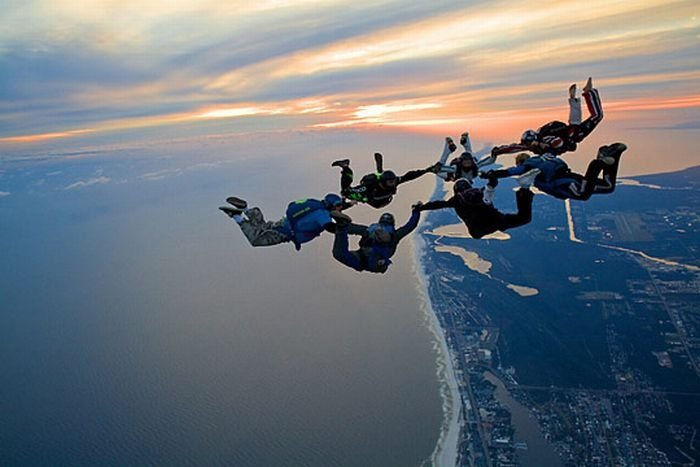|
|
Skydiving Photography
|
When the parachute opens (usually the parachute will be fully inflated by 800 meters or 2,600 feet) the jumper can control the direction and speed with toggles on the end of steering lines attached to the trailing edge of the parachute, and can aim for the landing site and come to a relatively gentle stop. All modern sport parachutes are self-inflating "ram-air" wings that provide control of speed and direction similar to the related paragliders. Purists in either sport would note that paragliders have much greater lift and range, but that parachutes are designed to absorb the stresses of deployment at terminal velocity.
By manipulating the shape of the body in freefall, a skydiver can generate turns, forward motion, backwards motion, and even lift.
When leaving an aircraft, for a few seconds a skydiver continues to travel forward as well as down, due to the momentum created by the plane's speed (known as "forward throw"). The perception of a change from horizontal to vertical flight is known as the "relative wind", or informally as "being on the hill". In freefall, skydivers generally do not experience a "falling" sensation because the resistance of the air to their body at speeds above about 50 mph (80 km/h) provides some feeling of weight and direction. At normal exit speeds for aircraft (approx 90 mph (140 km/h)) there is little feeling of falling just after exit, but jumping from a balloon or helicopter can create this sensation. Skydivers reach terminal velocity (around 120 mph (190 km/h) for belly to Earth orientations, 150-200 mph (240–320 km/h) for head down orientations) and are no longer accelerating towards the ground. At this point the sensation is as of a forceful wind.
Many people make their first jump with an experienced and trained instructor – this type of skydive may be in the form of a tandem skydive. During the tandem jump the instructor is responsible for emergency procedures in the unlikely event that they will be needed, therefore freeing the student to concentrate on learning to skydive. Other training methods include static line, IAD (Instructor Assisted Deployment), and AFF (Accelerated Free fall) also known as Progressive Free-Fall (PFF) in Canada.
|
|









